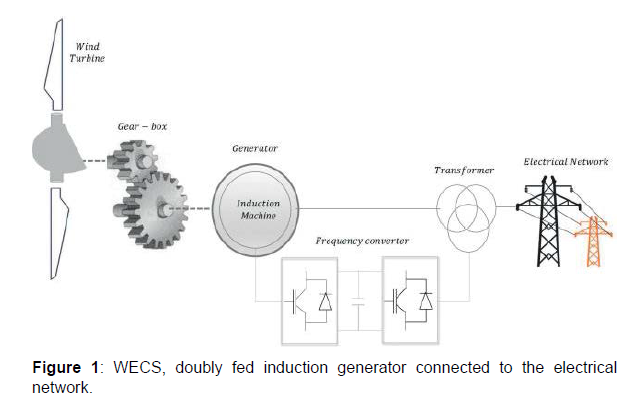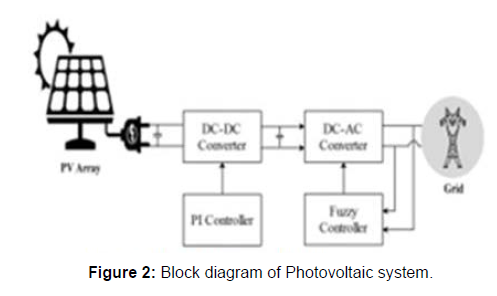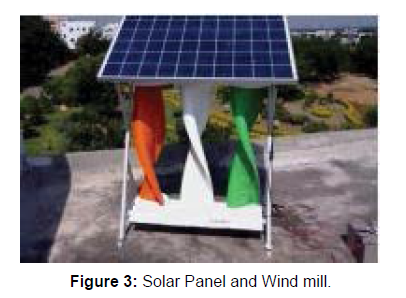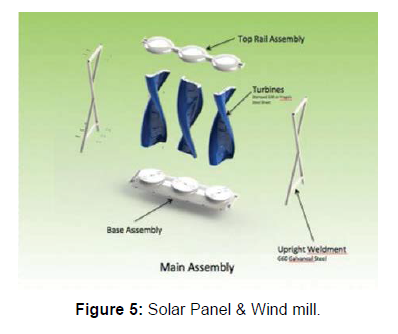Review paper on Power Quality improvement in Renewable energy systems
Received: 19-Oct-2021 / Accepted Date: 01-Nov-2021 / Published Date: 08-Nov-2021 DOI: 10.4172/2576-1463.1000249
Abstract
Now a days with the large growth of industrialization the demand for power is increasing. The environmental pollution, global heat etc, have made us to think for alternative source of energy called renewable energy source. These include solar, wind, hydro-power which is replacing the fossil fuels like thermal, nuclear etc which have very harmful effects with the release of CO2, SO2 and other harmful wastes, toxic gases which effect the environment very badly. These renewable energy source, solar is the powerful energy we receive from sun with free of cost without making any harm for environment. Along with this, wind energy also contributes for solving the power problem. These two sources are integrated with the grid. The Power quality plays a major role, where intelligent converters play a major role in the integration of wind and solar energy with the grid. Along with converters application of Flexible Ac Transmission Systems (FACTS) into the grid also helps in reducing power quality issues. In this paper we have discussed some of the hybrid techniques to be interfaced with the grid so that the power quality issues can be reduced.
Keywords
Wind energy systems; Solar PV systems; PQ issues; FACTS Controllers
Introduction
In these three decades, the growth of wind energy systems has tremendously increased world-wide. As per the available data in the year 2021, the generation and installed capacity of the wind power in India is 38.78 GW. India is the fourth largest installed wind power capacity in the world. The total wind energy generated is 180GW. The on shore wind power generation capacity is 86.9GW and offshore is of 6.1GW. These wind energy systems are clean, promising and reliable renewable energy source. The risk of disasters or pollution is avoided in when compared with or domestic purpose Nuclear power or with fossil fuels. The abundant energy which is available is being used by integrating to grid system. During this process the issues faced by consumer, generation system, distribution substation and researchers are power quality. In solar power generation system, voltage source inverter controller is used which generates reference current and a capacitor is suitably designed so that the power to the grid can be given without any power loss. Reactive power compensation and harmonic pollution can also be achieved by connecting a capacitor. The major power quality problems that are faced are
(i) Voltage sag or swell
(ii) Unbalanced or flickering voltage
(iii) Harmonics in current when load is connected
(iv)Unbalanced neutral current
(v) Transients and interruptions.
Wind Energy Conversion Systems (WECS)
Wind possesses energy by the virtue of its motion. Any device capable of slowing down the mass of moving air like a sail or propeller can extract part of energy and convert it into useful work. Wind energy is one of the effective and proven type of renewable energy where the usage is of 63GW in Mexico and reaches 433GW in total capacity of world wide. This energy is utilized in agriculture field to pump water and also for domestic purpose [1]. WECS is a complex electro-mechanical energy conversion system consists of many sub systems and components. Wind turbine is the most crucial part which uses power in wind for conversion. Turbines used for wind generation are divided into two types.
(i) Vertical Axis type model
(ii) Horizontal Axis type model.
Because of greater efficiency Horizontal Axis type model is commonly used, its components are like generator, rotor hub and blade, gear box and tower. In the earlier days they were using squirrel cage Induction generator for connecting to electrical network directly. There were many disadvantages like low efficiency, low power factor, poor power quality. This is overcome by using doubly fed Induction generator because of its higher efficiency, reduction in mechanical loads, simple system of pitch control and greater control of active and reactive power.
Since these winds are unpredictable still there are so many challenges like fluctuation of voltage generated, efficient coupling with electrical network. A clear harmonic analysis of WECS is required to overcome degradation of power quality, reduction of generator efficiency, malfunction of sensitive equipment, voltage or current signals occurring in electrical systems. WECS is as shown in Figure 1.
Solar PV Systems
Globalization and industrialization is escalating step by step, the energy requirement for human is increasing gradually. The solar energy is the non-conventional energy, which is obtained and maintaining them at a constant growth rate is the vital task. The leading topology of PV grid is the Inverter topology. As the crossing point devices across solar cells and the grid, inverter plays a crucial role in developing and consuming the new energy schemes, disturbing the financial side and consistency of the photovoltaic (PV) grid generation system openly [1].
The block diagram of proposed system Grid is as shown in figure 2. The solar PV system is a kind of electrical inverter that alters direct current from PV module into alternating current. When the PV system is associated to the grid, it can transmit the extra energy to the grid after satisfying the limited demand. But when the demand is more than the generation, extra energy is obtained from the grid. Thus, PV energy acts as another source of electricity [2]. The PV system, considered, aims to relocate electrical power from PV panel to the grid. Firstly, DC-DC Converter is used to boosts PV voltage to a higher level than the peak of grid voltage [3]. Power converters are used for interfacing the renewable energy system to power system. When the power converters are utilized, they introduce harmonics in the system. Conversely, the increased use of sensitive electronic circuits in the industries and household jointly with privatization and rivalry in electric energy.
PV Generation
The demand for solar energy is increasing day by day. The improvement in the field of solar energy is leading to the cheaper rate of PV cells and the prices are decreasing day by day. But solar energy installation cost is higher among the other available sources. The government is encouraging the customers by providing some incentives in order to encourage the usage of solar power. Primary installation cost is little bit costlier. The efficacy and rate are key factors on the PV system. The effectiveness of the PV circuit is moderately high and the unit rate is cheap due to its high-power capacity [3].
The enormous use of electrolytic condensers can reduce the life span. There are a variety of PV panels available. The module integrated inverter is implemented on the rear of the PV array casing should maintain insensitive under excess temperature circumstances. The duration of electrolytic condensers, which has shorter length than other apparatus and deeply depends upon operational temperature, becomes the key barrier to expand the life span of PV unit production. A dc PV generation crossing point is in view of proposed AC module. Considering the significance of the ac module theory, dc interfaced PV production systems are cheap and has higher effectiveness because of less transformation stages from source to stack. The consistency points are transmitted by uprooting the shorter lifespan of electrolytic condensers in the PV circuit. Therefore, PV cell can be modelled as a current source which generate current. The current flows in the reverse path and which is caused by a voltage between the terminals [4].
Application of FACTS Controllers
The FACTS controllers supply voltage support at critical buses in the system (with shunt connected controllers) and regulate power flow in critical lines (with series connected controllers). Both voltage and power flow are controlled by the combined series and shunt controller (UPFC) The power electronic control is quite fast and this enables regulation both under steady state and dynamic conditions [5].
The benefits due to FACTS controllers are listed below.
1. Improves voltage Profile and reduces power loss.
2. The ability of power carrying capacity of lines can be improved by having fast controllability and also by improving the operation margins.
3. Improves dynamic security of the system, by increasing transient stability limit and by reducing the blackouts caused by cascading outages [6].
4. The small signal stability region can be improved by providing auxiliary stabilizing controllers to damp low frequency oscillations.
5. FACTS controllers such as TCSC can counter the problem of Sub Synchronous Resonance (SSR) experienced with fixed series capacitors connected in lines evacuating power from thermal power stations [7].
6. The problem of voltage fluctuations, dynamic over voltages can be overcome by using FACTS controllers.
Power Quality Issues
In modern years, there has been a better importance and unease for the quality of power delivered to factories, business organizations and habitations. This is due to the increasing convention of harmonics creating due to nonlinear loads such as ASD, switched sort power supplies, arc furnaces, electronic fluorescent lamp ballasts etc. Power quality can be defined, as the revision of driving and establishing electronic frameworks so as to keep up the veracity of the power supplied to the system. IEEE criterion 1159 defines power quality to the model of powering and grounding perceptive equipment in an approach that is appropriate for the operation of that apparatus [8-12].
The power quality is meant to express the quality of voltage and quality of current. Also it can be defined as the measure, analysis and improvement of bus voltage to maintain a sinusoidal waveform at rated voltage and frequency. Superior power quality, however, is not easy to define because it is the superior power to a refrigerator motor, which may not be good for some current delicate equipment like computers and other sensitive loads [13-18]. Harmonic trouble come commonly from apparatus with a non-linear voltage/current features. As time goes on, additional and greater gear is being utilized that makes sounds in power frameworks. Computers, communication apparatus, and other power systems are vulnerable to miss operation due to the effects of harmonics. Because of the influence of these harmonics, the electric motors have major effect in the centre and copper windings. This can cause winding heating, torque fluctuation, and failure of efficiency in the motors [19-23].
Possible Solutions
The renewable energy sources such as solar, wind etc. has accelerated the transition towards greener energy sources. The increasing number of renewable energy sources and distributed generators requires new strategies for the operation and management of the electricity grid in order to maintain or even to improve the power-supply reliability and quality. Keeping in view of the aforesaid some of the possible solutions have been proposed such as installation of solar & wind hybrid system [24-26].
Installation of Solar & Wind Hybrid System
The Solar mill generates
(i) Energy from the sun and wind day time.
(ii) Energy from the wind day & night.
(iii) Energy even on cloudy days.
(iv) On hot sunny days more energy will be generated due to cooling effect on solar panels by wind.
(v) Standing at about 1 meter height, Solar Mill meets building code requirements.
(vi) Three Vertical-Axis Wind Turbines coupled to 3 permanent magnet generators.
(vii) On Board “Smart” Electronics include dynamic Maximum Power Point Tracking (MPPT) and connectivity (Figure 3).
Solar Mill Assembly
(i) Three Vertical Axis Turbines are mounted on a single base.
(ii) Cut-in wind speed- 2 m/s & Cut-out wind speed-18 m/s.
(iii) Turbines (Savonius) produce energy by accepting winds coming from any direction.
(iv) Designed for both On-Grid and Off-Grid applications (Figure 4 and 5).
Conclusion
In this paper, grid integration of Wind and Solar PV System, power quality issues and their possible solutions is discussed. The causes, affects, mitigation technologies featuring their topologies, highlighting the advantages of the grid integrated hybrid solar and wind power systems are being considered.
To minimize the fluctuations and intermittent problems power electronics devices are the feasible options. Further, energy storage and use of damp load and MPPT could be used for reducing the power fluctuations in PV systems. The up gradation in balance of systems by incorporating the new materials and storage elements could reduce the problems associated with grid integration. The cost-effective solutions of custom power devices and FACTS devices are highlighted to give an insight to the scope of research in low and medium level voltage networks.
References
- Mayoral EH, Lopez MAH, Marrero HJC, Cortez RI (2018) Harmonic analysis of the wind energy conversion system connected with electrical network
- Farooqi A, Othman MM, Abidin AF, Sulaiman SI, Radzi MAM (2019) Mitigation of power quality problems using series active filter in a microgrid system. Int J Power Electron Drive Syst 10: 2245-2253
- Singh M, Chandra A, Varma RK, Khadkikar V (2011) Grid interconnection of renewable energy sources at the distribution level with power-quality improvement features. IEEE Trans. Power Deliv 26: 307-315.
- Shiva C, Bhavani R, Prabha NR (2017) Power quality improvement in a grid integrated solar PV system. IEEE International Conference On Intelligent Techniques In Control, Optimization And Signal Processing.
- Muller S, Deicke M, Doncker RWD (2002) Doubly fed induction generator systems for wind turbines. IEEE Ind Appl Mag 8: 26-33.
- Hughes FM, Lara OA, Jenkins N, Strbac G (2005) Control of DFIG-based wind generation for power network support,†IEEE Trans Power Syst 20:1958-1966.
- Tan KK, Islam S (2004) Optimum control strategies in energy conversion of PMSG wind turbine system without mechanical sensor. IEEE Trans Energy Convers 19:392-399.
- Kumar V, Pandey AS, Sinha SK (2016) Grid integration and power quality issues of wind and solar energy system: A review. International Conference on Emerging Trends in Electrical Electronics & Sustainable Energy Systems (ICETEESES).
- Zaragoza J, Pou J, Arias A, Staines SC, Robles E, et al. (2011) Study and experimental verification of control tuning strategies in a variable speed wind energy conversion system. Renew Energy 36:1421-1430.
- Heetun KZ, Aleem SHEA, Zobaa AF (2016) Voltage stability analysis of grid-connected wind farms with FACTS: Static and dynamic analysis. Energy policy res 3:1-12.
- Gandoman FH, Sharaf AM, Aleem SHEA, Jurado F (2017) Distributed-FACTS stabilization scheme for efficient utilization of distributed wind energy systems. Int Trans Electr Energy Syst 27:2391.
- Liu Q, Li Y, Hu S, Luo L (2019) Power quality improvement using controllable inductive power filtering method for industrial DC supply system. Control Eng Pract 83:1-10.
- Nagaraju G, Shankar S (2020) Power quality improvement of wind energy conversion system with unified power quality controller: A hybrid control model. Trans Inst Meas Control pages 42:1-14.
- Singh M, Khadkikar V, Chandra A, Varma RK (2011) Grid interconnection of renewable energy sources at the distribution level with power-quality improvement features. IEEE Trans Power Deliv 26: 307-315.
- Suganthi L, Iniyan S, Samuel A (2015) Applications of fuzzy logic in renewable energy systems-A review. Renew Sustain Energy Rev 48:585-60.
- Litran SP, Salmeron P (2017) Electromagnetic compatibility analysis of a control strategy for a hybrid active filterâ€, Electr Power Syst Res 144: 81-88.
- Tareen WU, Mekhilef S, Mahmoudian MS, Horan B (2017) Active power filter (APF) for mitigation of power quality issues in grid integration of wind and photovoltaic energy conversion system. Renew Sustain Energy Rev 70: 635-655.
- Boutoubat M, Mokrani L, Zegaoui A (2017) Power quality improvement by controlling the grid side converter of a wind system based on a DFIG. IEEE 6th International Conference on Systems and Control (ICSC).
- Lei L, Shengtie W, Guichon T (2016) Grid power quality improvement with stator/hess for wind turbine with squirrel-cage induction generator. IEEE 11th Conference on Industrial Electronics and Applications (ICIEA).
- Tourou P, Chhor J, Sourkounis C, Gunther K (2017) Energy storage integration in DFIG-based wind energy conversion system for improved fault ride-through capability. IEEE 6th International conference on Renewable Energy Research and applications ICRERA 374-377.
- Hajiaghasi S, Salemnia A, Hamzeh H (2019) Hybrid energy storage system for microgrids applications: A review. J Energy Storage 21: 543-570.
- Zheng Y, Li S, Tan R (2018) Distributed model predictive control for on-connected microgrid power management. IEEE Trans Control Syst Technol 26:1028-1039.
- Jayachandran M, Ravi G (2019) Predictive power management strategy for PV/battery hybrid unit based islanded AC microgrid. Int J Electr Power Energy Syst 110: 487-496.
- Roslan MF, Hannan MA, Ker PJ, Uddin  MN (2019) Microgrid control methods toward achieving sustainable energy management. Appl Energy 240: 583-607.
- Pushparajesh V, Nandish BM, Marulasiddappa HB (2021) Hybrid intelligent controller-based torque ripple minimization in switched reluctance motor drive. Bull Electr Eng Inform 10:1193-1203.
- Pushparajesh V, Nandish BM, Marulasiddappa HB (2021) Torque Ripple Minimization in Switched Reluctance Motor using ANFIS Controller. WSEAS Trans Syst Control 16:171-182
Citation: Archana K, Pushparajesh V (2021) Review Paper on Power Quality Improvement in Renewable Energy Systems. Innov Ener Res, 10: 249. DOI: 10.4172/2576-1463.1000249
Copyright: © 2021 Archana K, et al. This is an open-access article distributed under the terms of the Creative Commons Attribution License, which permits unrestricted use, distribution, and reproduction in any medium, provided the original author and source are credited.
Select your language of interest to view the total content in your interested language
Share This Article
Recommended Journals
Open Access Journals
Article Tools
Article Usage
- Total views: 2613
- [From(publication date): 0-2021 - Dec 09, 2025]
- Breakdown by view type
- HTML page views: 1900
- PDF downloads: 713





